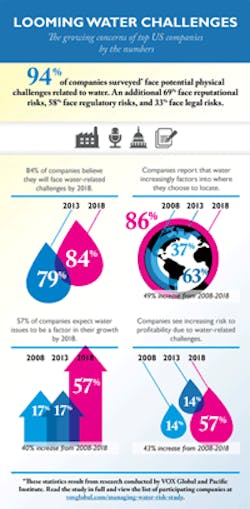Survey Finds Water on the Minds of U.S. Corporations
Angela Godwin, Chief Editor
Strategic public affairs firm VOX Global and the Pacific Institute, an environmental research think tank, recently surveyed more than 50 companies across a diverse array of sectors to understand corporate perception of water risk and how they plan to address it.
Despite the fact that most companies believe the next five years will see a worsening of water challenges, the majority of respondents are not planning any proportionate increases in the scope of their water risk management strategies. Almost 70 percent said that their current level of investment in water management is sufficient.At the same time, a fair number of the responding companies -- nearly 60 percent -- felt that water is likely to have a negative impact on business growth and profitability within the next five years. And when it comes to finding locations for their facilities, an overwhelming majority -- over 80 percent -- said water will play a role in the decision.
It's rather interesting that there seems to be a disconnect between concern over water-related challenges and taking action to address them. The researchers suggested that internal obstacles could be to blame. "Business leaders we surveyed pointed to two significant internal obstacles that hinder companywide buy-in to water: lack of time to raise awareness and buy-in, and other risks ranking as a higher, more immediate priority," said Tony Calandro, Senior Partner and leader of the VOX Corporate Sustainability and Social Responsibility Practice Group.
Because water-related risk and response tends to be highly localized, some companies may not have an overarching water strategy but rather delegate water-related responses to specific business units and facilities. This approach unfortunately contributes to the perception that water is peripheral to core business strategy.
The researchers pointed out that a lack of understanding of the "true cost" of water may also be impacting companies' ability to see water risk as a high priority. As a stand-alone cost, water remains relatively cheap (as compared to electricity costs, for example). However, the researchers said that companies that look closely at costs associated with water find a variety of hidden costs, enabling them to better appreciate the financial benefit of addressing water-related issues.
In general, though, the researchers felt that the marked increase in corporate awareness and acknowledgement of water as a business issue is significant. "As more and more corporate boards discuss the impact of social and environmental issues on their profitability and growth, topics such as water risk will emerge as central to company strategy," said Calandro. "This new economic reality necessitates that companies better understand the many ways that water affects their reputation and bottom line and the multitude of communication and management strategies they may need to adequately address these business challenges."
If you are interested in reading the full report, "Bridging Concern and Action: Are US Companies Prepared for Looming Water Challenges?," you can find it online at www.pacinst.org.

